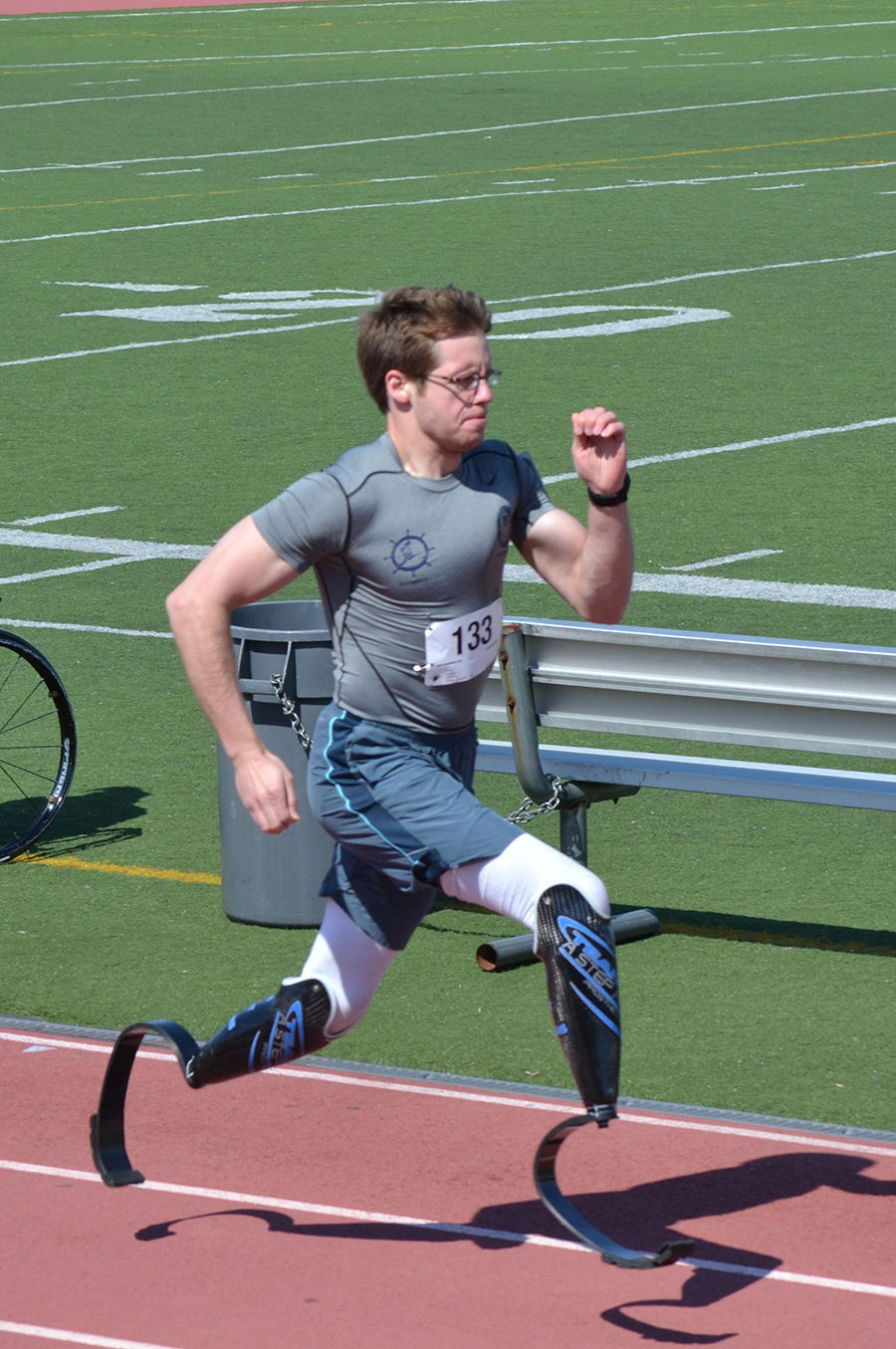Brian Reynolds nearly won the Pacific Missile Range Facility’s 5K Sunset Run on July 19. Out of about 100 runners, he finished in 21 minutes, 10 seconds, just a second behind the winner, Jackie Reding of Kapaa. His time, his place,
Brian Reynolds nearly won the Pacific Missile Range Facility’s 5K Sunset Run on July 19.
Out of about 100 runners, he finished in 21 minutes, 10 seconds, just a second behind the winner, Jackie Reding of Kapaa. His time, his place, impressive by any standards.
Considering that he was running with prosthetic legs, even more so.
And to think, had this been a race just on roads and without trails, first place might have been his.
“I started near the front and just tried my best to hang on to the two frontrunners. The trails are a bit hard for me to run. The treads on my running blades kept picking up the gravel and I was sliding all over the place. I put a lot of energy into staying at the front,” he said. “When we hit the first mile marker, we were running a 6:35 pace and I was winded which worried me. Normally, I can carry that pace.”
Reynolds, though, charging hard on carbon-fiber lower legs, reeled in the leaders.
“At the turnaround point I felt a lot more recovered, and my spirits were boosted as I passed by my wife who yelled encouragement and spurred me on. At that point, I caught up to the second-place runner and passed him. I was steadily gaining ground on Jackie, who had pulled way ahead,” he said. “On the return trip I was sure I was going to catch her on the open road but then we hit the trails again. I tried to give it one last spurt as we hit the open road and probably came within five feet of her but she was just too fast.”
Still, runner-up on a road race on Kauai, during his honeymoon with his wife, not a bad day.
“We loved it and will be coming back frequently,” the New Jersey man said.
Reynolds has always been ready to line up and just go. He recounts losing his legs below the knees at the age of four to meningococcemia and considers himself lucky.
“I say lucky because if I had to lose my legs it was much better it happen at a young age. There were very little adaptions for me, it is simply all that I have known,” he said. “So the many challenges of getting used to prosthetics was downgraded for me.”
His legs for walking cost around $15,000 each and his running legs, about $25,000. Insurance helps, but doesn’t cover everything.
“As a growing child you need to get a new set most years and as an adult that likes more extreme activities and has a tendency to be good at breaking legs you need them even more,” he said.
“My family is certainly not rich which meant paying for my legs growing up left us a bit tight on money, I can’t imagine how much my amazing parents sacrificed for me.”
He credits family and friends for seeing him through rough patches. Believing in yourself, he added, is critical.
“They have always cheered me on and kept me going which is why I have been able to do so much,” he said. “One of my main obstacles growing up was getting over my own self-consciousness. I wore strictly pants until the age of about 21, if people asked about my limp, I always made up some sort of injury or excuse, it wasn’t until I became more confident in myself and who I am that I truly started to flourish in life.”
That he did.
His accomplishments, by his current age of 26, include hiking Half Dome in Yosemite, the Grand Canyon, Zion, the Inca Trail Peru and most recently Kilimanjaro, along with some trekking across the Sahara. Two years ago, he took up running. He learned one thing: he was fast.
“I have always wanted to run but never thought that I would be able to,” said the 2010 graduate of Saint Anselm College in Manchester, New Hampshire. “Two years ago I decided I was going to run or die trying.”
He didn’t die.
He started running one minute a day on a treadmill and about a month and a half later, ran his first mile.
Since, he has raced distances from 100 meters to 400 meters on the track, to 5Ks and a marathon on the roads. He’s run a sub five-minute mile and recently joined the Paralympic Track Club in New Jersey and hopes to compete in the 2016 Paralympics.
An Ironman, completing the 135-mile Badwater ultramarathon and hiking Denali and Everest are on his bucket list.
Reynolds relies on high-intensity, low-mileage running and mixes in weight training.
“Because I am an amputee, running takes a much larger toll on the skin of my legs than it would for most people,” he said.
Brian is about fun, too, He’s trying to win Runner’s World Cover Photo Contest. Voting is open through Aug. 26, and yes, he would appreciate your vote.
Running, he said, is like therapy.
“Running is freedom to me, I feel like I am flying when I am out on the roads or trails, every time I pull on my running legs is a reminder of what I never thought I could do. It is exhilarating and it provides a challenge every time,” he said.
Key for the Boston native is pushing through physical and mental barriers.
“I enjoy both the encouragement that everyone who passes me offers, just as much as I love to hear that I am inspiring and motivational just by doing what I love best,” Reynolds said. “Through running, I have found a community of friends, neighbors, coaches and family who will always be a major part of my life. I run because I feel free.”


